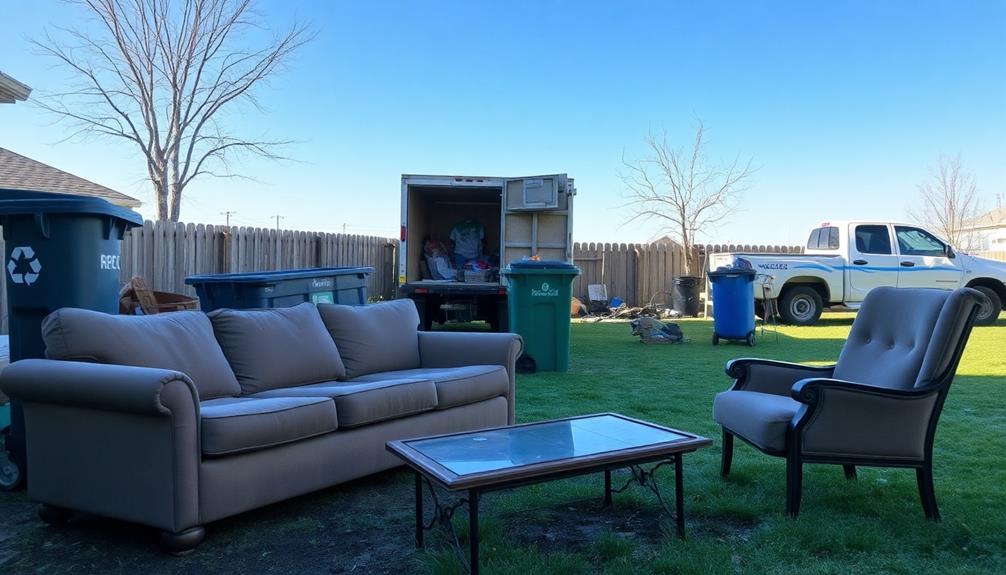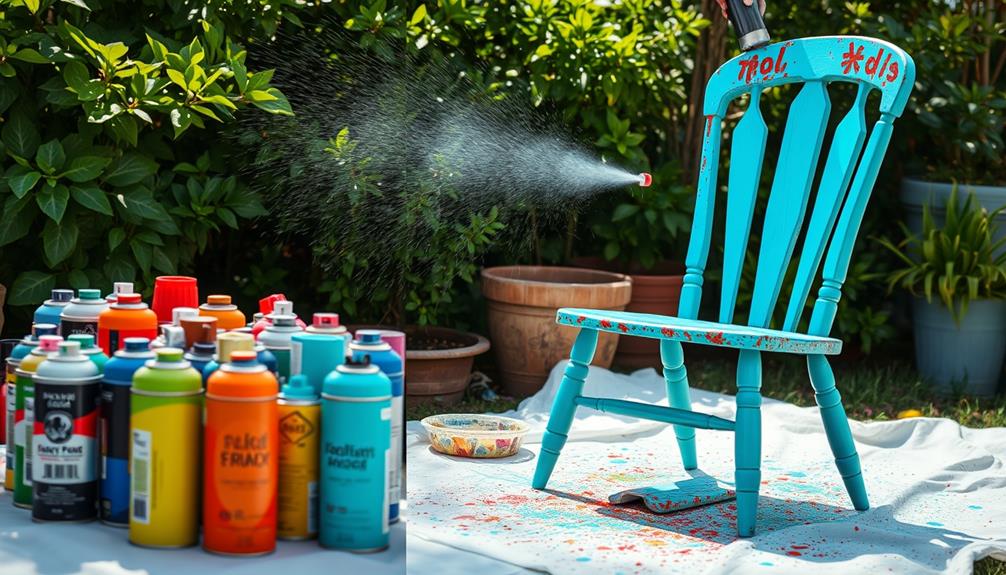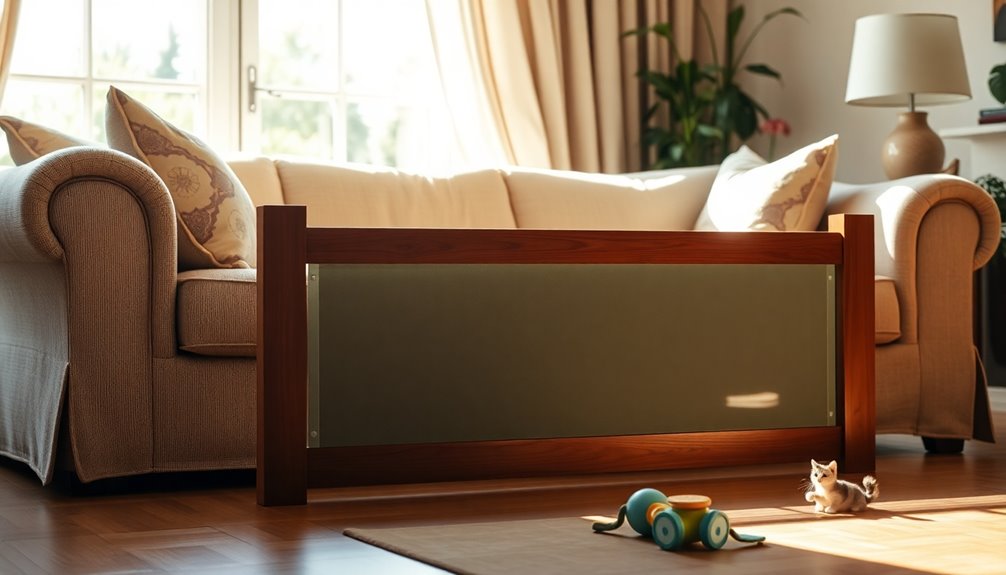To get rid of old furniture, first assess its condition. If it’s in good shape, think about donating it to local charities or shelters. For items that can’t be donated, recycling or upcycling are good eco-friendly options. You can also consider hiring junk removal services that focus on responsible disposal. If selling is your preference, platforms like Craigslist and Facebook Marketplace can help you connect with potential buyers. For larger quantities, renting a dumpster could be a convenient choice. Make sure to check your local regulations regarding bulky item pick-up and disposal procedures. There are many ways to handle your old furniture in a productive manner!
Key Takeaways
- Assess the furniture's condition to determine if it can be donated, recycled, or needs to be disposed of as junk.
- Donate gently-used furniture to local charities, shelters, or online community groups for tax-deductible contributions.
- Explore recycling programs and upcycling options to repurpose or responsibly dispose of furniture materials.
- Schedule curbside bulk item pick-up with local waste management, following guidelines for placement and preparation of items.
- Consider hiring junk removal services for eco-friendly disposal, ensuring items are recycled or donated properly.
Assessing Furniture Condition
When you're ready to dispose of old furniture, the first step is evaluating its condition. Start by examining the structural integrity; check for broken legs, loose joints, or significant wear that could affect usability. If the furniture's damaged, it might need to be disposed of rather than donated. Understanding the common financial terms related to the costs of disposal can also help in budgeting for this process.
Next, inspect the upholstery. Look for stains, tears, or odors that could lessen the chances of a successful donation or resale.
Turn your attention to functionality as well. Verify all moving parts—like drawers or reclining mechanisms—work properly. Non-functional items often can't be donated and should be contemplated for disposal instead.
Don't forget to reflect on the age and style of your furniture. Older, vintage pieces may hold some resale value, while outdated designs typically aren't in high demand.
Finally, think about the environmental impact of your disposal choices. If your furniture can be recycled or repurposed, it's worth exploring those options. A responsible approach to disposal not only benefits you but also contributes positively to the environment.
Donation Options
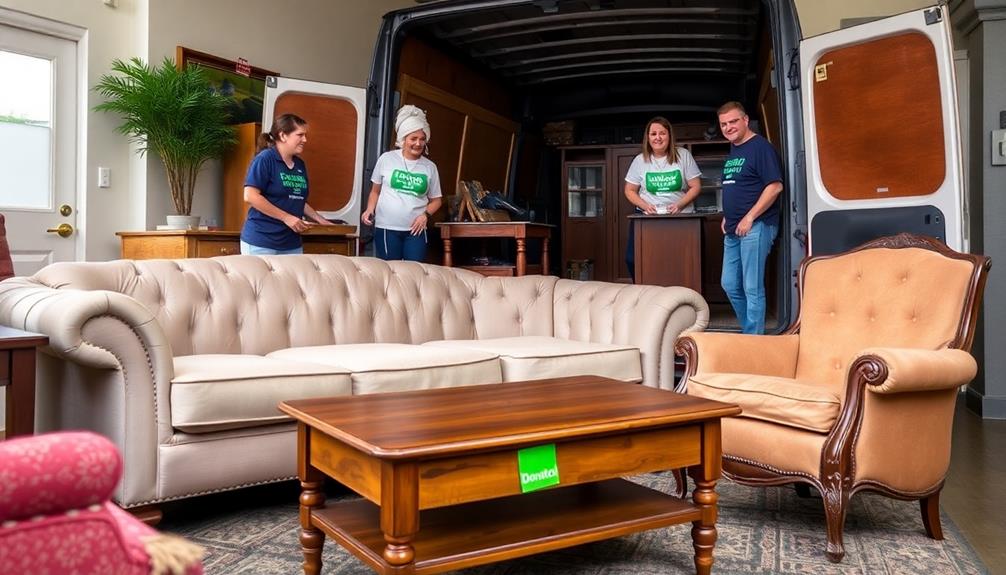
Donating old furniture is a great way to give back to the community while clearing out your space. Many local charities, like Goodwill and Habitat for Humanity, accept gently-used furniture donations and often offer free pick-up services for larger items.
Additionally, community organizations, including shelters, are always in need of furniture for families in flux. This act of kindness not only benefits those in need but also supports emotional and psychological well-being, similar to caregiver support resources for families managing elderly care.
Here are some excellent options for donating your furniture:
- Donation centers: Check local centers for guidelines on accepted items to guarantee your donations meet their criteria.
- Online platforms: Join Buy Nothing groups on Facebook or similar platforms to give away your furniture directly to neighbors in need.
- Tax-deductible contributions: Donating furniture can be a win-win. You can receive a receipt for your contributions, making them tax-deductible and beneficial during tax season.
Before you donate, confirm that your furniture is in good condition and free of major damage.
Recycling and Upcycling
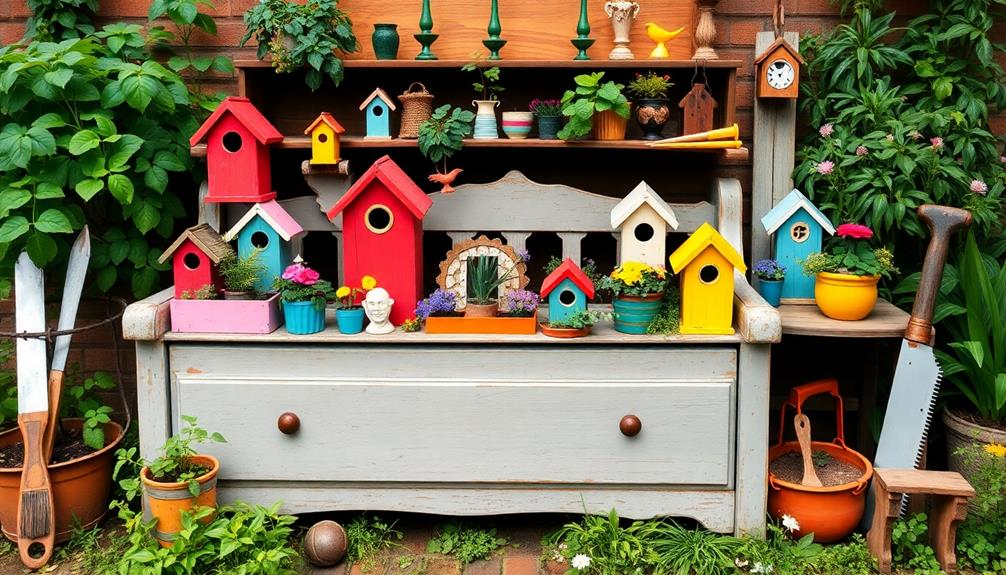
When it comes to recycling and upcycling your old furniture, you've got some great options. Many local programs can help you responsibly recycle materials, while creative upcycling ideas allow you to transform pieces into unique items for your home.
For instance, you might consider turning an old chair into a decorative plant stand or using reclaimed wood to create a rustic shelf. Not only does this reduce waste, but it also benefits the environment and showcases your personal style, aligning with modern farmhouse decor trends that emphasize natural materials and sustainability.
Creative Upcycling Ideas
Upcycling old furniture is a fantastic way to breathe new life into discarded pieces while also being kind to the environment. You can transform your old furniture into creative, functional items that not only reduce waste but also save money.
For those looking to enhance their outdoor spaces, consider how DIY fire pit ideas can complement your upcycled furniture. Here are a few transformative upcycling ideas to inspire your DIY projects:
- Turn an old dresser into a stylish TV stand: With a fresh coat of paint, it can become a centerpiece in your living room.
- Use wooden pallets to create a rustic coffee table: Just sand them down, add some legs, and you've got a chic piece.
- Repurpose furniture parts: Transform chair legs into unique picture frames or an old door into a trendy dining table.
Adding new hardware, like knobs or handles, can dramatically change the aesthetic of your old furniture, making it feel modern and customized.
These creative projects not only enhance your home but also contribute to environmentally friendly disposal methods. So, gather your tools and let your imagination run wild—upcycling is a rewarding way to give your old furniture a second life!
Local Recycling Programs
Finding a responsible way to dispose of old furniture can make a significant difference in reducing waste. Many local recycling programs in Houston accept various furniture items, promoting the repurposing of materials to minimize landfill overflow.
Additionally, some organizations offer trusted precious metal IRA services to help you make informed investment decisions for your future. You can check with the City of Houston's Solid Waste Management Department for updated information on recycling options and guidelines specific to furniture disposal.
Consider participating in recycling centers that may have designated drop-off days for larger items. This encourages community participation and helps guarantee responsible disposal practices.
Additionally, local charities often partner with these recycling programs to divert usable furniture from landfills, providing it to those in need.
If you're feeling creative, explore upcycling initiatives in your area. These programs offer workshops and resources to transform old furniture into stylish, functional pieces.
Not only does this foster creativity, but it also supports sustainability by giving new life to items that might otherwise be discarded.
Benefits of Recycling Furniture
Recycling furniture not only helps the environment but also offers a range of benefits that enhance your community and personal life. By choosing recycling options like furniture donations and upcycling furniture, you can greatly reduce landfill waste and contribute to a more sustainable future.
Additionally, engaging in creative projects, such as primitive weapons for modern survival, can inspire innovative approaches to repurposing old furniture.
Here are some key benefits of recycling furniture:
- Support Local Charities: Donating your old furniture to local charities provides those in need with usable items, fostering community spirit.
- Encourage Sustainability: Upcycling furniture extends the lifespan of materials and conserves resources, promoting a circular economy that reduces the environmental impact of manufacturing new products.
- Financial Gains: Refurbishing old pieces can lead to financial benefits, as you can sell them for a profit or enhance your home's aesthetics without the cost of new purchases.
Curbside Disposal Guidelines
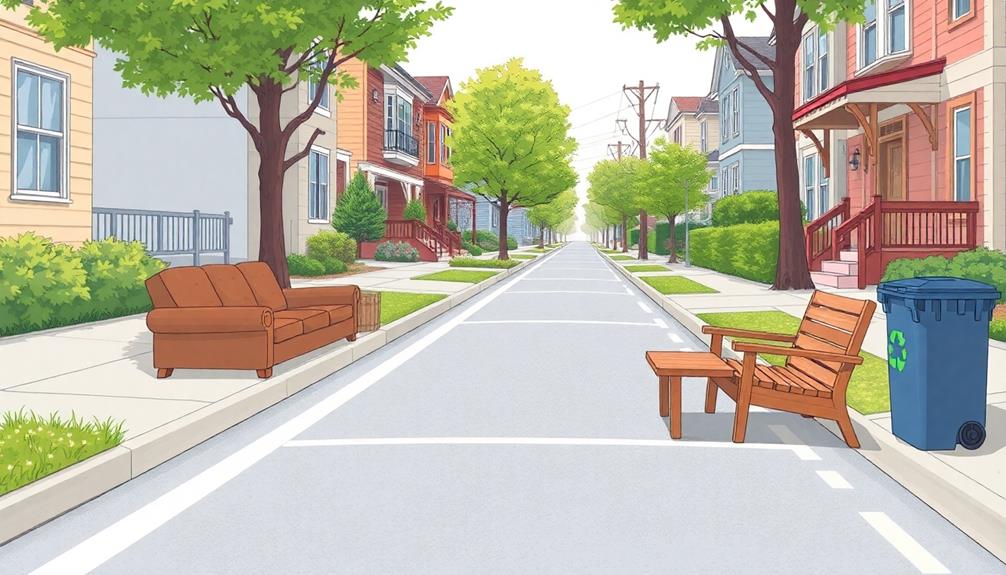
When it comes to disposing of old furniture, understanding curbside disposal guidelines is crucial for a smooth process. To start, you'll need to schedule a bulky item pick-up with your local waste management service. This guarantees proper collection and avoids any surprises on pick-up day.
Remember, items should be placed at the curb no earlier than 24 hours before your scheduled pick-up, and make sure they're accessible—free from vehicles or other obstacles. Additionally, if you're considering upgrading your home security, you may want to check out the value of home security systems to protect your new items after disposal.
Local regulations may require you to break down large items into smaller pieces to facilitate easier handling. Check with your waste management provider for specific disposal methods and guidelines.
Also, don't forget that hazardous materials, such as chemicals or refrigerants from appliances, need to be disposed of following local hazardous waste disposal regulations.
Lastly, familiarize yourself with the list of accepted items for curbside disposal, as some services may not pick up certain types of furniture or materials. By following these guidelines, you can guarantee a hassle-free furniture removal experience while staying compliant with local regulations.
Hiring Junk Removal Services
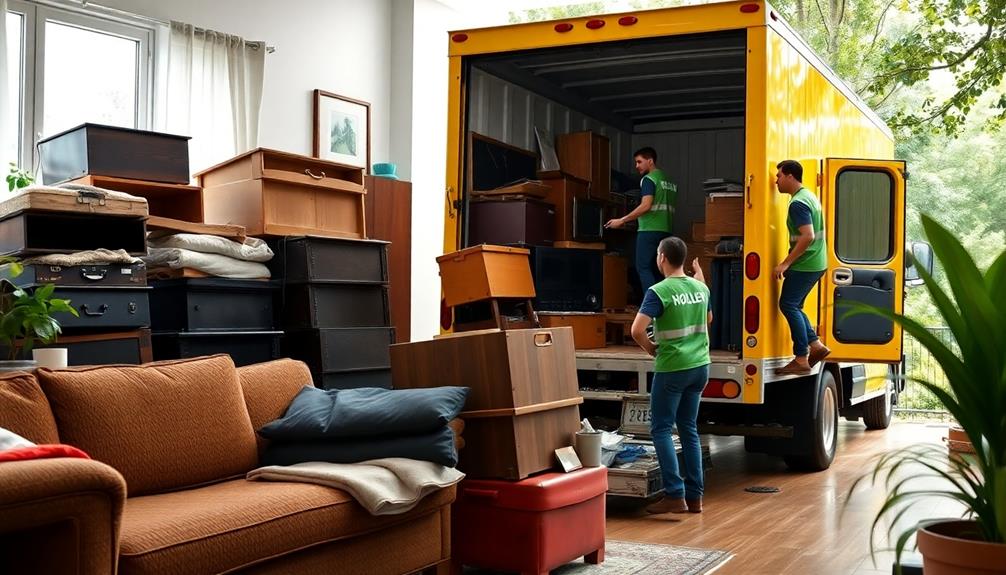
When you're ready to get rid of old furniture, hiring junk removal services can make the process smooth and eco-friendly.
Many of these services also provide top-rated mechanic shops known for their efficient handling of various items, guaranteeing that your disposal needs are met with professionalism.
Companies like Fire Dawgs not only handle heavy lifting but also focus on transparent pricing, so you won't face any surprise fees.
Plus, their commitment to recycling and donating helps guarantee that your unwanted items are disposed of responsibly.
Eco-Friendly Removal Practices
If you're looking to dispose of old furniture responsibly, hiring eco-friendly junk removal services is a smart choice. These companies prioritize sustainability and can guarantee that over 60% of your disposed items are reused, recycled, or donated, markedly reducing landfill impact.
Additionally, many of these services are knowledgeable about local recycling guidelines and can help you navigate the disposal process effectively, guaranteeing that items such as wood and metal are properly sorted and processed for recycling common types of cold medications.
When you choose eco-friendly junk removal, you'll benefit from:
- Efficient logistics: They handle all the heavy lifting and transportation, guaranteeing compliance with local disposal regulations.
- Community welfare: Many services donate usable items to local charities, contributing to those in need.
- Specialized equipment: Trained crews use specialized trucks designed for efficient sorting and processing of materials.
Transparent Pricing Estimates
Transparent pricing estimates are essential when hiring junk removal services, as they help you understand exactly what you'll pay before any work begins. Many reputable companies, like Fire Dawgs, offer free in-person estimates, ensuring transparency and no hidden fees.
When you prepare an inventory of items for removal, you can receive accurate estimates, making the process smoother and avoiding surprises on your final bill. Additionally, exploring best websites to earn money online can provide you with some financial flexibility to cover disposal costs.
Typically, a crew chief assesses the volume and type of items to be removed and provides a final estimate based on that assessment. This keeps you informed throughout the entire process.
If you can't meet in person, sending pictures or videos of your items can yield quick electronic estimates, further streamlining scheduling.
With transparent pricing, you'll only pay for the junk removal services you receive. Understanding different disposal methods can also influence your choices, as some services might charge more based on the type of items being disposed of.
Selling Furniture Online
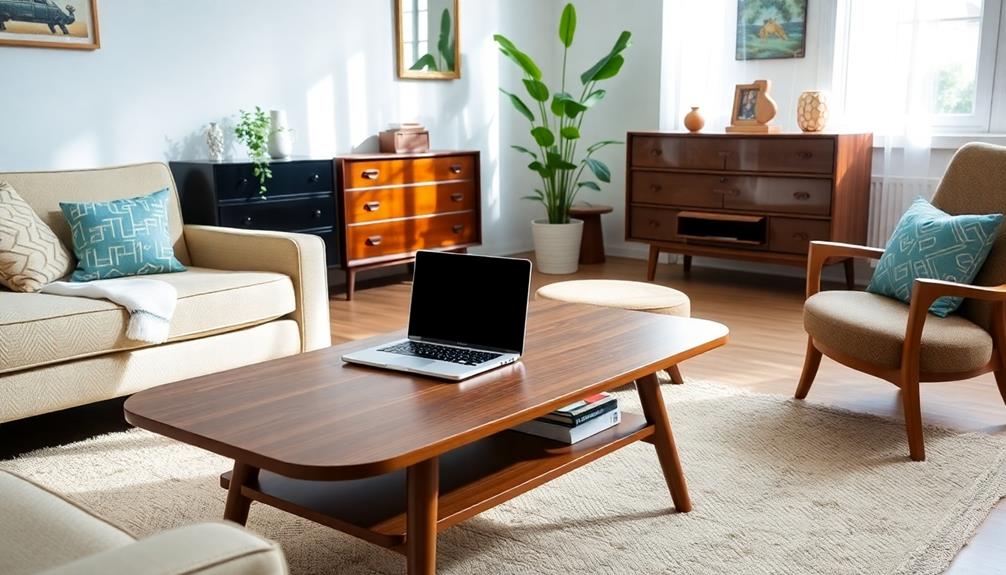
Selling your old furniture online can be a quick and effective way to declutter while making some extra cash. Platforms like Craigslist, Facebook Marketplace, and OfferUp let you connect with local buyers, making the process easier.
To boost your chances of a successful sale, consider these tips:
- Use high-quality photos: Clear, well-lit images show off your furniture's best features.
- Write detailed descriptions: Include dimensions, condition, and any unique aspects to attract interest.
- Research pricing: Look at similar listings to price your furniture competitively and guarantee you get a fair value.
When you're ready to list, clear communication with potential buyers is key. Be transparent about item condition and discuss pick-up or delivery arrangements upfront. This helps facilitate smooth transactions and manage expectations.
Lastly, prioritize safety when meeting buyers. Choose public locations for exchanges, and if possible, bring a friend along to enhance security.
Renting a Dumpster
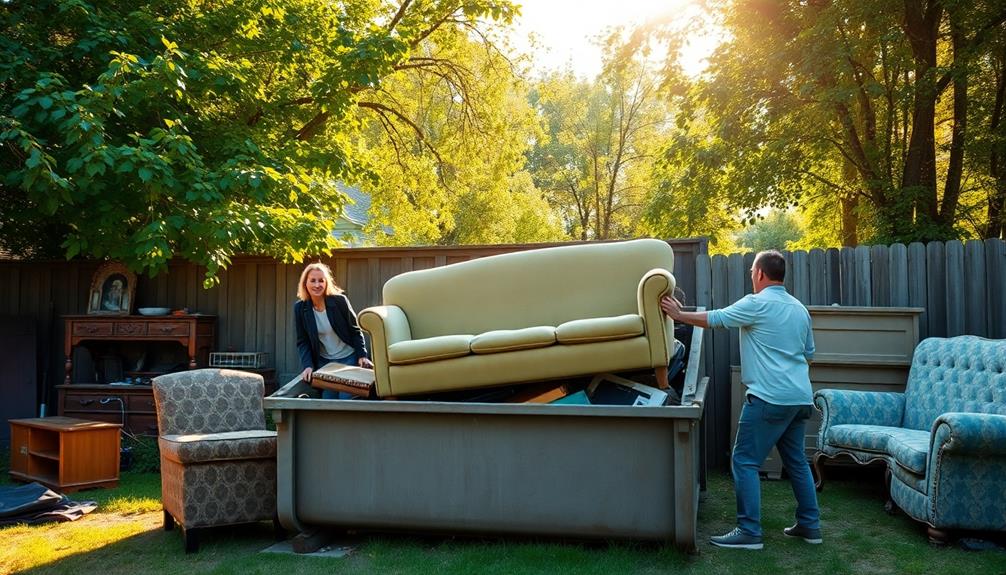
When it comes to disposing of larger furniture items, renting a dumpster can be a practical solution. This option provides the flexibility you need to discard items at your own pace, especially during renovation cleanouts.
Most dumpster rental services offer a variety of sizes, ranging from 10 to 40 cubic yards, ensuring you select one that fits your furniture disposal needs.
Before committing, get upfront quotes from different companies. This helps you budget effectively for the rental period and any associated fees, preventing unexpected costs.
Keep in mind that hazardous materials and liquid waste are prohibited in rental dumpsters, so make sure you comply with local regulations when loading your items.
Many rental companies also offer convenient drop-off and pick-up services, streamlining the disposal process and minimizing hassle for you.
With these services, you can focus on your renovation or cleanout without worrying about transporting heavy furniture to the landfill.
Local Regulations and Resources

Understanding local regulations is essential for proper furniture disposal. In Houston, it's important to check the Solid Waste Management Department's guidelines for curbside pickup and bulky item disposal. Ignoring these regulations can lead to fines, so be aware of scheduled pickup days.
To make your furniture disposal easier, consider these options:
- Bulky Item Pickups: The City offers scheduled pickups a few times a year for larger items, making disposal convenient without incurring fees.
- Donation Services: Many local charities and shelters accept usable furniture and often provide free pick-up services, which can be a great way to help others.
- Waste Management Services: Contact local services or visit their websites to find information on accepted items and any associated fees for disposal.
Frequently Asked Questions
How Do I Get Rid of All My Furniture?
You've got several options to get rid of all your furniture. Schedule a pick-up, donate to charity, sell online, or hire a junk removal service. Just make sure you follow local disposal regulations to avoid fines.
How Do I Get Rid of an Old Sofa for Free Near Me?
To get rid of your old sofa for free, check local waste management for curbside pickup, consider donating to charities, list it online in community groups, or find junk removal services that might take it away. Some recycling centers may also accept large furniture items if they meet certain criteria, so it’s worth checking with them as well. Additionally, consulting online resources or local forums can provide more specific advice on how to get rid of a sofa in your area. Be sure to plan ahead, as some services may require an appointment or specific disposal guidelines. If you’re environmentally conscious, you might also explore options to repurpose or upcycle parts of the sofa, such as using the cushions or fabric for DIY projects. Taking the time to dispose of your sofa responsibly ensures that you minimize waste and contribute to sustainable practices. With a little research and planning, you can find the most eco-friendly or community-benefiting way to handle unwanted furniture.
How Much to Pick up a Sofa?
To pick up a sofa, expect to pay between $75 and $150, depending on the service and location. Check for free estimates and possible discounts if you're removing multiple items at once.
Conclusion
Now that you know the various ways to dispose of your old furniture, imagine how satisfying it'll be to see that clutter cleared away. Whether you choose to donate, recycle, or sell, each option can lead to a fresh start. But wait—what if you discover a hidden gem among your pieces? Could that old chair have a story waiting to be told? The choice is yours, but the thrill of uncovering possibilities lies just ahead.
